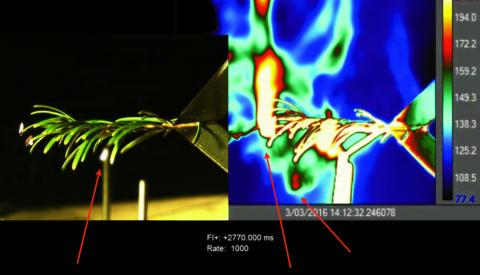Research conducted at the Missoula Fire Lab has found that the amount of radiant heat in wildland fires is not sufficient to ignite fine fuel particles such as needles and grasses. These fine fuels are highly efficient at convective heat transfer, so any amount of airflow can easily offset the radiant heat generated by the fire. As a consequence, fine wildland fuels do not ignite until bathed by the flame. As radiant heating has been assumed to drive ignition in wildland fires as it does in structural fires, ignition by convective heating is not well understood.
Experiments are conducted to determine if and how ignition due to convective heating is different than that from radiative heating. An apparatus was built using two electrical heaters to heat air up to 800°C (1500°F). Wood cylinders and disks of different diameters and thicknesses have been tested. A simple model has been shown to predict the ignition times of these simple fuels with reasonable accuracy. Several differences between convective and radiative heating have been noted. For example, the convective heating and ignition process is far more sensitive to fuel size and shape than radiative heating. Another major difference between these modes of ignition is the large surface temperature gradient that forms due to convective heating that is largely missing under the radiant heating of an approaching wildfire.
The ignition process of live fuels has also been examined using this convective heating apparatus. Using side-by-side highspeed visual and infrared cameras, various species of live fuels have been observed to produce jets of flammable gases in an explosive manner prior to the sustained ignition of the entire fuel clump. This behavior confirms that different processes occur in the ignition of live fuels that are not present in dead fuels. Further work is needed to assess just how these additional processes contribute and control the ignition of live fuels.
Understanding the ignition process due to convective heating will allow for better prediction of the transition from surface to crown fire and crown fire spread, two aspects of wildland fire behavior that are largely misunderstood.
